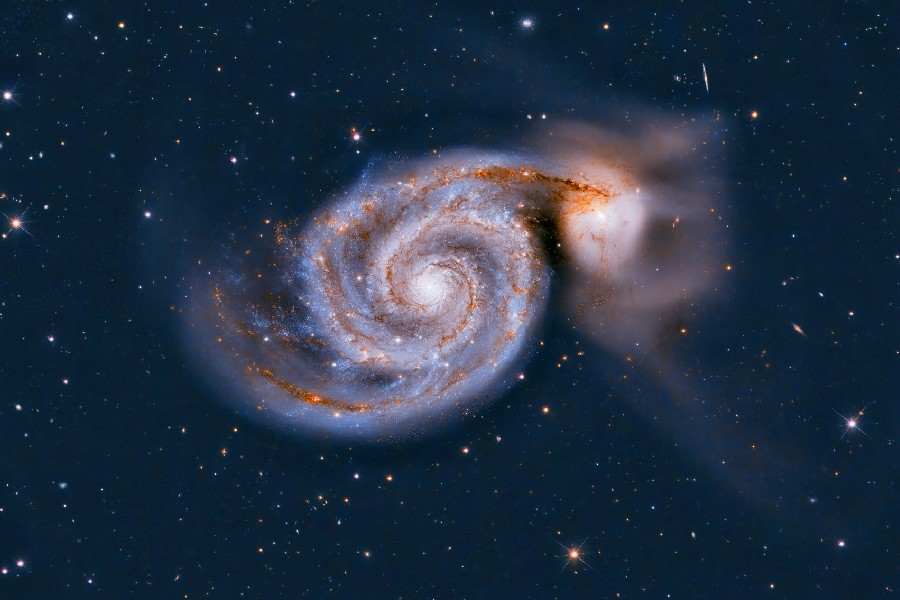Among the multitude of galaxies in our observable universe, few are as recognizable and visually striking as the Whirlpool Galaxy. Located approximately 31 million light-years from Earth, this spiral beauty reveals intricate details about the nature of galaxies.
These details can be viewed through ground and space-based telescopes when the Whirlpool Galaxy is observed. In this article, we will explore some of the most fascinating Whirlpool Galaxy facts.
The Whirlpool Galaxy has captivated astronomers for centuries with its iconic face-on view from Earth and remarkable properties like its supermassive black hole. We will look at details ranging from its discovery and observation history to current understandings of its structure, contents, and place within our galactic neighborhood.
This article will help you better comprehend the inner workings of spiral galaxies like our own Milky Way. Join us on a journey to unlock the secrets of the Whirlpool Galaxy, a cosmic wonder that continues to draw our gaze across time and space.
Most Interesting Whirlpool Galaxy Facts
The Whirlpool Galaxy, or Messier 51, graces the constellation Canes Venatici with its mesmerizing spiral arms and bright nucleus.
Situated 32 million light-years away, its allure is heightened by a gravitational dance with NGC 5195, fostering vibrant star formation. Charles Messier’s 1773 discovery marked M51, a visual feast for astronomers and astrophotographers.
Hosting an active galactic nucleus, indicative of a central supermassive black hole and adorned with dark dust lanes, the galaxy unveils many mysteries.
These mysteries can be seen in both visible and infrared spectrums when observing the Whirlpool Galaxy. This captivating cosmic neighbor stands as a testament to the dynamic interplay shaping the celestial tapestry of captivating sky enthusiasts.

The Whirlpool Galaxy – A Snapshot
As mentioned above, the Whirlpool Galaxy distance to Earth is 31 million light-years. Whirlpool Galaxy location is Canes Venatici. Its face-on orientation provides a clear view of its structure. It neighbors NGC 5195, which may have spurred star formation through gravitational interactions.
The Whirlpool Galaxy has a majestic spiral structure with curving arms extending from its bright bulge. Its perspective allows detailed study of spiral patterns. It contains many young, luminous stars clustered along its arms likely due to galaxy interactions.
Facts About the Whirlpool Galaxy
Dances with a companion
The Whirlpool Galaxy interacts gravitationally with a smaller companion galaxy. This dance shapes its spiral structure and triggers star formation. Tidal forces and gaseous collisions compress interstellar gas and dust within the Whirlpool’s arms. This stimulates stellar nurseries.
Harbors stellar nurseries
The Whirlpool Galaxy’s arms harbor stellar nurseries where stars are born. These regions contain vast, dense clouds of gas and dust. Gravity causes the clouds to fragment and collapse to form new stars. The nurseries produce bright, young stars that congregate along the arms.
Showcases a light show spectacle
Images of the Whirlpool Galaxy highlight its cosmic grandeur. Captured in visible and infrared light, photos showcase its graceful spiral arms, bright star clusters, and dark dust lanes. These images contribute to scientific understanding and public fascination with the galaxy’s beauty.
Hubble captured the sharpest view of the Whirlpool Galaxy
An iconic 1995 Hubble Space Telescope image unveiled unprecedented details of the Whirlpool Galaxy. This was the sharpest view ever of its spiral structure. Hubble’s capabilities advanced knowledge and unlocked clues about galaxies. The image remains a landmark achievement.
It’s visible with binoculars
Remarkably, the Whirlpool Galaxy can be spotted with binoculars or a small telescope from a dark sky location. Whirlpool Galaxy size and brightness make this cosmic wonder accessible to amateur astronomers. A modest instrument can reveal its glowing form, encouraging public exploration of its celestial splendor.
It’s a magnet for amateur astronomers
The Whirlpool Galaxy is a favorite target for amateur astronomers. Its brightness, recognizable structure, and northern hemisphere location make it accessible. Stargazers are drawn to the galaxy’s beauty. It is an ideal object to glimpse through a backyard telescope.
Lies 31 million years away from Earth
Despite its grandeur, the Whirlpool Galaxy lies 31 million light-years distant. Its beauty spans the immense gulf of intergalactic space.
From this faraway island universe, we learn much about the nature of galaxies. The Whirlpool’s distance highlights the scale of cosmic frontiers yet to be explored.
Conclusion
From its gravitational dance with a companion galaxy to its majestic spiral structure glowing with stellar nurseries, our tour through remarkable Whirlpool Galaxy facts has illuminated this celestial wonder.
Its iconic beauty captured in groundbreaking telescope images reminds us that galaxies far exceeding human lifetimes and distances remain dynamic places hosting immense dramas.
It’s not just an impressive object visible to amateur astronomers. It’s also a subject of intrigue that advances our knowledge about the workings of galaxies across the cosmos.
As we continue studying our island universe neighbors like the Whirlpool, more fascinating revelations surely await to deepen our understanding of our galactic story.
